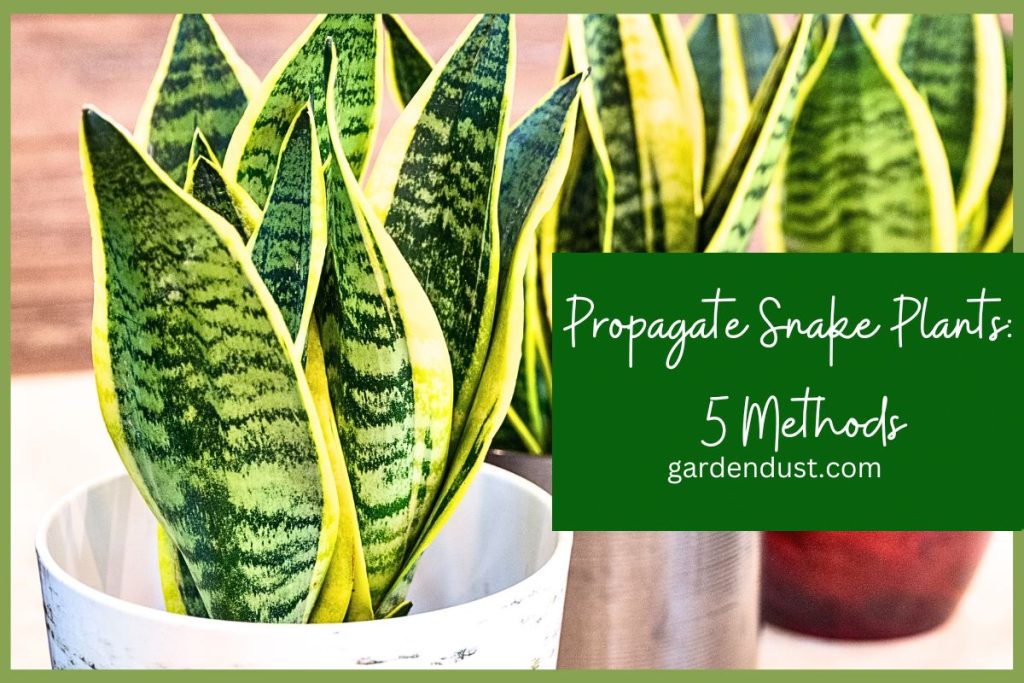Snake plants (Sansevieria), also known as Mother-in-Law’s Tongue, are renowned for their striking appearance and low-maintenance nature. With their upright sword-like leaves and air-purifying capabilities, these plants have become a favorite among both beginner and experienced gardeners. One of the intriguing aspects of snake plants is their ability to propagate through various methods. In this article, we will delve into the detailed steps of 5 Various Methods of Propagate Snake Plants several propagation techniques to help you expand your snake plant collection. Let’s start….
1. Division
Division is a simple and effective method of propagating snake plants that involves separating the offshoots or “pups” from the main plant. This technique is ideal when your snake plant has outgrown its pot or has produced multiple offsets.
Steps:
- Prepare the Pot: Choose a new pot with well-draining soil. Make sure it’s slightly larger than the pot you’re currently using for the mature snake plant.
- Remove the Plant: Gently remove the snake plant from its current pot, being cautious not to damage the roots.
- Separate Offsets: Inspect the plant for offsets – smaller plants growing at the base. These can be gently detached from the main plant using a clean, sharp knife or your hands. Each offset should have its own set of roots.
- Plant the Offsets: Plant each offset in the new pot, ensuring that the roots are covered with soil and the plant is stable. Water lightly.
- Care: Place the newly potted offsets in indirect light and avoid overwatering. Gradually increase the amount of light they receive as they establish themselves.
2. Leaf Cuttings
Propagating snake plants from leaf cuttings is another method that can yield satisfying results. This method involves taking a healthy leaf and encouraging it to develop new roots and shoots.
Steps:
- Select a Leaf: Choose a healthy leaf from the snake plant. Use a sharp, clean knife to cut the leaf into sections that are about 2-3 inches long.
- Cure Cuttings: Allow the cuttings to air dry for a day or two. This helps prevent rot when planting.
- Plant the Cuttings: Plant the cuttings in a well-draining soil mix, burying about a third of the cutting into the soil.
- Provide Light and Humidity: Place the pot in a bright, indirect light location. Cover the pot with a plastic bag or a clear plastic dome to create a humid environment.
- Root Development: After a few weeks, you should see roots developing. At this point, you can remove the plastic covering.
- Transplanting: Once the cuttings have established roots and new growth, you can transplant them into individual pots.
3. Rhizome Cuttings
This method involves taking a cutting from the underground rhizome of the snake plant. Rhizome cuttings can lead to quicker propagation compared to leaf cuttings.
Steps:
- Choose a Rhizome: Select a healthy rhizome from the base of the plant. A rhizome is a horizontal stem that grows beneath the soil.
- Cut the Rhizome: Use a sharp, clean knife to cut a section of the rhizome that has a few inches in length. Make sure the cutting has some roots attached to it.
- Plant the Cutting: Plant the rhizome cutting in a well-draining soil mix, burying it partially in the soil.
- Provide Adequate Conditions: Place the pot in a warm, indirect light location and water lightly. Avoid overwatering, as rhizomes are susceptible to rot.
- New Growth: In a few weeks, you should see new shoots emerging from the cutting. This indicates successful propagation.
- Transplanting: Once the new shoots have grown a few inches tall and have their own set of leaves, you can transplant them into individual pots.
4. Water Propagation
Water propagation is a popular method for many houseplants, including snake plants. It involves placing cuttings or leaf sections in water until they develop roots.
Steps:
- Prepare Cuttings: Take healthy leaf cuttings or leaf sections and place them in a container of water. Ensure that the cut end is submerged.
- Change Water Regularly: Change the water every few days to prevent stagnation and the growth of mold.
- Root Development: After a few weeks to a couple of months, you should see roots developing from the cut end of the leaf.
- Planting: Once the roots are a few inches long, transplant the cuttings into well-draining soil in individual pots.
5. Offsets in Water
This method involves allowing offsets to develop roots in water before transplanting them into soil.
Steps:
- Separate Offsets: Gently remove offsets from the main plant.
- Place in Water: Place the offsets in a container of water, submerging only the root portion while keeping the rest of the plant above water.
- Root Development: As the offsets remain in water, they will gradually develop roots over a few weeks.
- Transplanting: Once the roots are a few inches long, carefully transplant the offsets into well-draining soil in individual pots.
Final Thoughts
Propagating snake plants can be a rewarding endeavor that allows you to expand your collection and share these beautiful plants with others. Whether you choose division, leaf cuttings, rhizome cuttings, water propagation, or growing offsets in water, each method has its unique advantages and processes. By following the detailed steps outlined in this article, you can confidently experiment with different propagation techniques and enjoy the growth of new snake plants right before your eyes. Happy Gardening…






